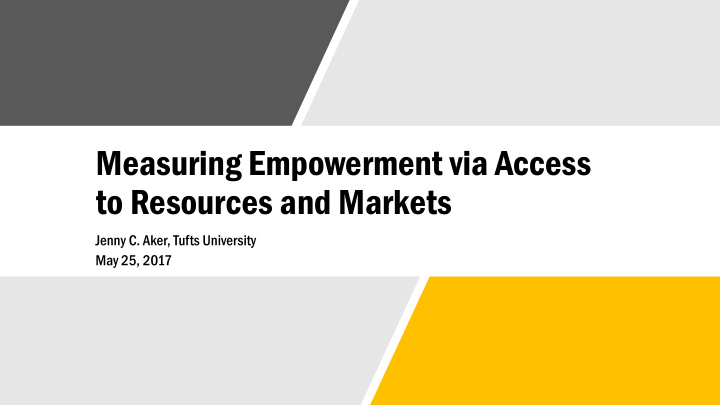



Measuring Empowerment via Access to Resources and Markets Jenny C. Aker, Tufts University May 25, 2017
• Intra-household dynamics are complex and often unobservable Why External • Intra-household decision-making is difficult to measure and can vary along different Measures of dimensions Empowerment? • Is joint decision-making always better? • Access to markets and resources can (in theory) signal that women are more empowered
Measures of Empowerment Chain Indic dicator ators Cash Transfer Program Targeting Women Cash transfer received 1. Inputs by woman Who spends cash Provide cash transfer to woman transfer within household 2. Outputs Woman controls spending Woman invests more in of cash transfer herself How cash transfer is spent Intra-household Woman invests more in Woman exerts more influence in Increased use of formal decision-making household 3. Outcomes 1 other household decisions financial services Access to formal financial services New businesses, Labor market participation Consumption, Improved welfare 4. Outcomes 2 expenditures, health outcomes 4
The Ethnic “Border” 98% Zarma 95% Hausa 99% Muslim 99% Muslim 95% of women are self- 95% of women are self- employed employed A Thought Women can travel to Women do not travel to markets alone or in groups markets alone or in groups Experiment 10% of traders are women 0% of traders are women 30% are members of 62% are members of savings savings groups groups 35% polygamous 31% polygamous Less than 1% save in a Less than 1% save in a formal financial institution formal financial institution These villages are about 10 km apart: How do we come up with common (external) measures of empowerment? Is access to financial services and financial services meaningful?
Indicators of Women’s Empowerment in Niger and DRC “Internal” Measures “External” Measures • Intra-household decision-making (ie, • Engaged in livestock-raising and sales decisions on spending on school and (“ embouche ”) health fees, travel outside of the village, • “Involved” in selling agricultural financial support to relatives, decisions production about agricultural production) • Knowledge of market prices • • Spending on women’s and children’s • Traveled to market clothing for Muslim festivals • Members of savings group • *Mobile phone ownership and usage Conclusion: These can be highly context specific, even within a small geographic area
• IFPRI Women’s Empowerment in Agriculture Index (access to and decision-making power over productive resources, control over use of income, leadership in the community, time use). How do these • UNDP’s Gender Inequality Index (labor force participation) compare with other indicators? • GSMA (women’s mobile phone ownership) • IPA 2017 report of existing findings (employment, earnings, access to and usage of formal and informal accounts) • But is women’s empowerment correlated with other welfare improvements?
• The 2017 IPA report suggests that a key issue is to “ increase women’s mobile phone ownership, since the expansion of digital payments, and mobile money, in particular, is limited by women’s access to and use of mobile phones. “ Mobile Phone • In a RCT in Niger, distributing mobile Ownership and phones in the context of a cash transfer Usage? program did not increase women’s control over the phone , unless it the cash was disbursed via the mobile phone • Is it ownership or usage? What if women’s usage is correlated with literacy and other issues?
Recommend
More recommend